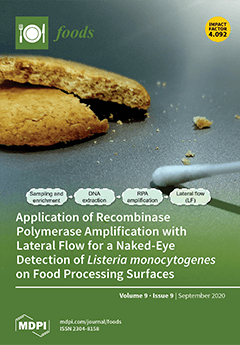Caulerpa racemosa (Forsskal) J. Agardh is a green seaweed used as food and folk medicine since ancient times in the Indo-Pacific region, particularly in southeast Asia. In this study, the proximate nutrient composition, phytochemical, anti-oxidant and anti-diabetic properties of sea grape
C. racemosa
[...] Read more.
Caulerpa racemosa (Forsskal) J. Agardh is a green seaweed used as food and folk medicine since ancient times in the Indo-Pacific region, particularly in southeast Asia. In this study, the proximate nutrient composition, phytochemical, anti-oxidant and anti-diabetic properties of sea grape
C. racemosa collected from culture fishponds in Johor, Malaysia were analysed. The contents (dry weight basis) of carbohydrate, crude protein, crude lipids, ash and caloric value obtained were 33.42 ± 1.34%, 20.27 ± 0.14%, 4.20 ± 0.32%, 28.25 ± 0.27% and 2544.67 ± 7.04 cal g
−1, respectively. The amino acid score (AAs) and biological protein value (213.43 mg g
−1) indicated that
C. racemosa presented a better protein quality. The most abundant fatty acids were C16:0 (palmitic acid: 63.27%), followed by C18:1 (oleic acid: 5.80%), and C18:2 ῳ6 (linoleic acid: 5.33%). The analysis of the ash content indicated that essential minerals and trace elements, such as Ca, Fe, and Mn, were present in the seaweed. The total phenolic content (TPC) and total flavonoid content (TFC) observed in the ethyl acetate extract were 17.88 ± 0.78 mg GAE g
−1 and 59.43 ± 2.45 mg QE g
−1, respectively. The ethyl acetate extract of
C. racemosa demonstrated notable anti-diabetic activity in diabetic induced rats. The low (100 mg kg
−1) and high (200 mg kg
−1) doses of cultivated
C. racemosa extract exhibited a significant decrease (
p < 0.05) in blood glucose levels while preventing weight loss, reducing plasma AST, ALT levels as a sign of hepatoprotective effect and recording albumin levels similar to positive control in diabetic induced rats. The results support the usefulness of cultivated
C. racemosa as a potential functional food.
Full article






